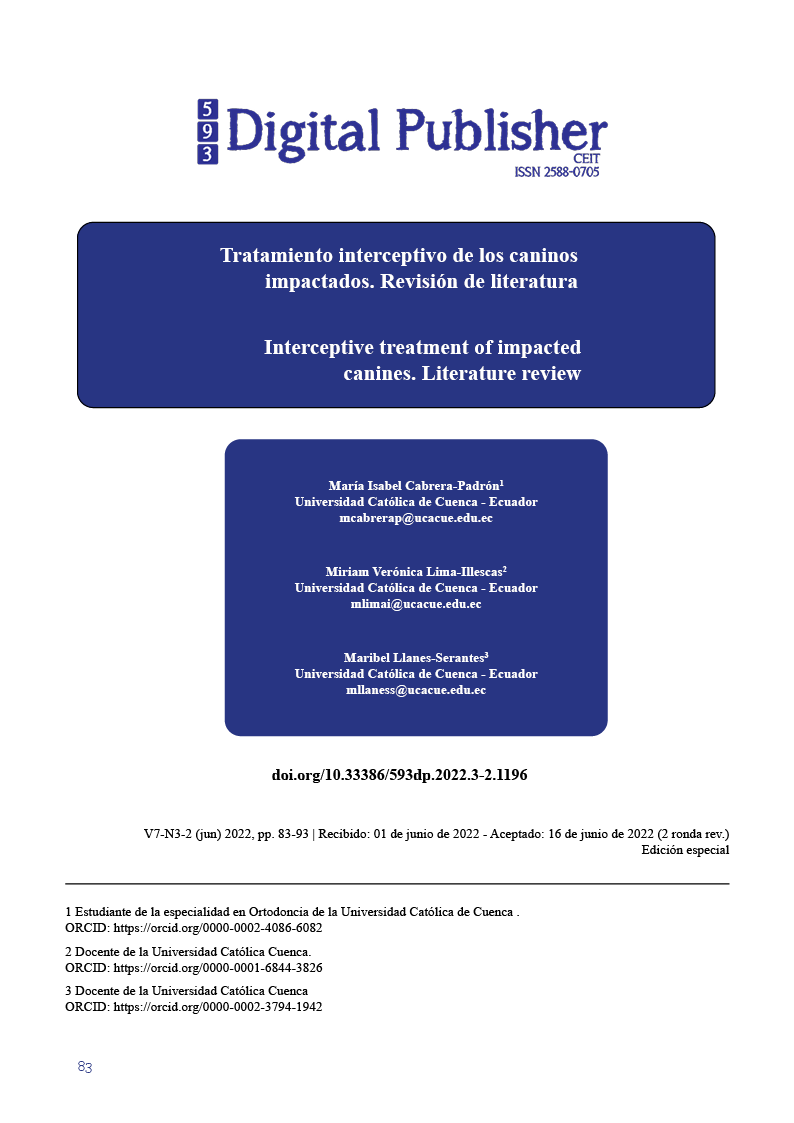Interceptive treatment of impacted canines. Literature review.
Main Article Content
Abstract
An impacted tooth is one that does not erupt into the dental arch in the desired time, so a timely and effective diagnosis is necessary in order to determine the appropriate therapy to be carried out. The objective is to analyze the existing publications on the interceptive therapeutic procedures recommended to avoid canine impaction. Articles were analyzed and obtained from four digital databases: PubMed, Scopus, Web of Science, Bvs, the keywords were selected from "Mesh" using the Boolean operator AND, Orthodontics, Interceptive, Tooth, Impacted, Cuspid, Maxilla. Inclusion criteria were: clinical case reports, case-control studies, randomized clinical trials, systematic reviews, meta-analysis, articles published in the last 5 years, in English and Spanish, articles published until January 2022 and open access. The literature evaluated the effectiveness of interceptive treatment of impacted canines and it was determined that there is a high eruption rate in cases in which extractions of primary teeth have been performed, improving the results when mesialization of the first molar is avoided. It was evidenced that the interceptive procedures performed in cases of impacted canines the extraction of the canines plus the use of cervical traction harness or transpalatal bar accompanied by the rapid expansion of the maxilla will result in a change of the environment, direction and position of the impacted tooth resulting in a spontaneous eruption.
Downloads
Article Details

This work is licensed under a Creative Commons Attribution-NonCommercial-ShareAlike 4.0 International License.
1. Derechos de autor
Las obras que se publican en 593 Digital Publisher CEIT están sujetas a los siguientes términos:
1.1. 593 Digital Publisher CEIT, conserva los derechos patrimoniales (copyright) de las obras publicadas, favorece y permite la reutilización de las mismas bajo la licencia Licencia Creative Commons 4.0 de Reconocimiento-NoComercial-CompartirIgual 4.0, por lo cual se pueden copiar, usar, difundir, transmitir y exponer públicamente, siempre que:
1.1.a. Se cite la autoría y fuente original de su publicación (revista, editorial, URL).
1.1.b. No se usen para fines comerciales u onerosos.
1.1.c. Se mencione la existencia y especificaciones de esta licencia de uso.
References
Al-Abdallah, M., AlHadidi, A., Hammad, M., & Dar-Odeh, N. (2018). What factors affect the severity of permanent tooth impaction? BMC Oral Health, 18(1), 1–7. https://doi.org/10.1186/s12903-018-0649-5
Alyammahi, A. S., Kaklamanos, E. G., & Athanasiou, A. E. (2018). Effectiveness of extraction of primary canines for interceptive management of palatally displaced permanent canines: A systematic review and meta-analysis. European Journal of Orthodontics, 40(2), 149–156. https://doi.org/10.1093/ejo/cjx042
Andrade, I., Paschoal, M. A. B., & Santos, T. de O. (2019). Spontaneous eruption of severely impacted teeth: The report of two cases. Journal of Clinical and Experimental Dentistry, 11(5), e491–e495. https://doi.org/10.4317/jced.5491
Arboleda-Ariza, N., Schilling, J., Arriola-Guillén, L. E., Ruíz-Mora, G. A., Rodríguez-Cárdenas, Y. A., & Aliaga-Del Castillo, A. (2018). Maxillary transverse dimensions in subjects with and without impacted canines: A comparative cone-beam computed tomography study. American Journal of Orthodontics and Dentofacial Orthopedics, 154(4), 495–503. https://doi.org/10.1016/j.ajodo.2017.12.017
Barros, S. E., Hoffelder, L., Araújo, F., Janson, G., Chiqueto, K., & Ferreira, E. (2018). Short-term impact of rapid maxillary expansion on ectopically and normally erupting canines. American Journal of Orthodontics and Dentofacial Orthopedics, 154(4), 524–534. https://doi.org/10.1016/j.ajodo.2018.01.011
Benson, P. E., Atwal, A., Bazargani, F., Parkin, N., & Thind, B. (2021). Partn2. Interventions for promoting the eruption of palatally displaced permanent canine teeth, without the need for surgical exposure, in children aged 9 to 14 years. Cochrane Database of Systematic Reviews, 2021(12). https://doi.org/10.1002/14651858.CD012851.pub2
Bjerklin, K. (2020). Orthodontic management of impacted maxillary canines. APOS Trends in Orthodontics, 10(2), 64–71. https://doi.org/10.25259/APOS_41_2020
Björksved, M., Magnuson, A., Bazargani, S. M., Lindsten, R., & Bazargani, F. (2019). Are panoramic radiographs good enough to render correct angle and sector position in palatally displaced canines? American Journal of Orthodontics and Dentofacial Orthopedics, 155(3), 380–387. https://doi.org/10.1016/j.ajodo.2018.05.015
Boonpratham, S., Pariyatdulapak, N., Poonpiriya, T., Peanchitlertkajorn, S., & Saengfai, N. N. (2021). The efficacy of rapid palatal expansion on the eruption of impacted maxillary canine: A systematic review. Australasian Orthodontic Journal, 37(2), 273–283. https://doi.org/10.21307/aoj-2021.030
Camarena-Fonseca, A. R., Rosas Gonzales, E. J., Cruzado-Piminchumo, L. M., & Liñán Durán, C. (2017). Métodos de diagnóstico imagenológico para optimizar el plan de tratamiento y pronóstico de caninos maxilares. Revista Estomatológica Herediana, 26(4), 263. https://doi.org/10.20453/reh.v26i4.3033
Caprioglio, A., Castiglioni, F., Sambataro, S., Giuntini, V., Comaglio, I., Lorvetti, F., & Fastuca, R. (2020). Changes in canine inclination after rapid and slow maxillary expansion compared to untreated controls. Orthodontics and Craniofacial Research, 23(3), 351–356. https://doi.org/10.1111/ocr.12377
Crincoli, V., Tettamanti, L., Lucchina, A. G., Dedola, A., Cazzolla, A. P., Lacaita, M. G., & Mastrangelo, F. (2019). Correlation between maxillary canine impaction and facial biotype. Journal of Craniofacial Surgery, 30(4), 1044–1048. https://doi.org/10.1097/SCS.0000000000005279
De Stefani, A., Bruno, G., Visentin, S., Lucchi, P., & Gracco, A. (2021). Rapid maxillary expansion for interceptive orthodontic treatment of palatally displaced canine: A systematic review. European Journal of Paediatric Dentistry, 22(2), 139–143. https://doi.org/10.23804/ejpd.2021.22.02.10
Elangovan, B., Pottipalli Sathyanarayana, H., & Padmanabhan, S. (2019). Effectiveness of various interceptive treatments on palatally displaced canine–a systematic review. International Orthodontics, 17(4), 634–642. https://doi.org/10.1016/j.ortho.2019.08.002
Gandía-Aguiló, V., Cibrián, R., Soria, E., Serrano, A. J., Aguiló, L., Paredes, V., & Gandía, J. L. (2017). Use of self-organizing maps for analyzing the behavior of canines displaced towards midline under interceptive treatment. Medicina Oral, Patologia Oral y Cirugia Bucal, 22(2), e233–e241. https://doi.org/10.4317/medoral.21509
Ghaffar, F., Sukhia, R. H., & Fida, M. (2019). Association between maxillary transverse discrepancy and occurrence of potentially impacted maxillary canines in mixed dentition patients. International Orthodontics, 17(3), 554–561. https://doi.org/10.1016/j.ortho.2019.06.016
Grisar, K., Luyten, J., Preda, F., Martin, C., Hoppenreijs, T., Politis, C., & Jacobs, R. (2021). Interventions for impacted maxillary canines: A systematic review of the relationship between initial canine position and treatment outcome. Orthodontics and Craniofacial Research, 24(2), 180–193. https://doi.org/10.1111/ocr.12423
Hadler-Olsen, S., Sjögren, A., Steinnes, J., Dubland, M., Bolstad, N. L., Pirttiniemi, P., Kerosuo, H., & Lähdesmaki, R. (2020). Double vs single primary tooth extraction in interceptive treatment of palatally displaced canines: A randomized controlled trial. Angle Orthodontist, 90(6), 751–757. https://doi.org/10.2319/031920-196.1
Harada-Karashima, M., Ishihara, Y., Kamioka, H., & Kanomi, R. (2021). Age-related changes in the effect of rapid maxillary expansion on the position of labially impacted maxillary canines: A case-control study. American Journal of Orthodontics and Dentofacial Orthopedics, 159(3), 305–311. https://doi.org/10.1016/j.ajodo.2019.10.026
Lövgren, M. L., Dahl, O., Uribe, P., Ransjö, M., & Westerlund, A. (2019). Prevalence of impacted maxillary canines — An epidemiological study in a region with systematically implemented interceptive treatment. European Journal of Orthodontics, 41(5), 454–459. https://doi.org/10.1093/ejo/cjz056
Lövgren, M. L., Ransjö, M., Uribe, P., & Westerlund, A. (2021). Dental age in children with impacted maxillary canines. Acta Odontologica Scandinavica, 79(4), 289–295. https://doi.org/10.1080/00016357.2020.1843189
Margot, R., Maria, C. D. L. P., Ali, A., Annouschka, L., Anna, V., & Guy, W. (2020). Prediction of maxillary canine impaction based on panoramic radiographs. Clinical and Experimental Dental Research, 6(1), 44–50. https://doi.org/10.1002/cre2.246
Muslim, H., & Naoumova, J. (2021). Palatally displaced and impacted canines – What is taught during postgraduate orthodontics training in Europe? APOS Trends in Orthodontics, 11(1), 62–73. https://doi.org/10.25259/apos_109_2020
Sharma, V. K., Shukla, N. K., Chaturvedi, T. P., & Singh, S. (2021). Variables to predict spontaneous eruption of palatally displaced permanent canine after interceptive extraction of primary canine: A systematic review and meta-analysis. International Orthodontics, 19(1), 25–36. https://doi.org/10.1016/j.ortho.2020.11.004
Shehare, Namrata; Tarvade, Suchita; Kaurani, H. (n.d.). Canine impactation: Diagnosis and management. Retrieved February 24, 2022, from https://www.webofscience.com/wos/woscc/full-record/WOS:000720082300007
Simić, S., Pavlović, J., Nikolić, P. V., Vujačić, A., Vukićević, V., & Jovanović, R. (2019). The prevalence of peg-shaped and missing lateral incisors with maxillary impacted canines. Vojnosanitetski Pregled, 76(1), 61–66. https://doi.org/10.2298/VSP170225079S
Stabryła, J., Plakwicz, P., Kukuła, K., Zadurska, M., & Czochrowska, E. M. (2021). Comparisons of different treatment methods and their outcomes for impacted maxillary and mandibular canines: A retrospective study. Journal of the American Dental Association, 152(11), 919–926. https://doi.org/10.1016/j.adaj.2021.05.015
Ugolini, A., Cerruto, C., Fastuca, R., Giuntini, V., Doldo, T., Silvestrini-Biavati, A., & Caprioglio, A. (2020). Upper canine response to rapid maxillary expander anchored to deciduous vs. permanent molars. Journal of Orofacial Orthopedics, 81(3), 220–225. https://doi.org/10.1007/s00056-020-00222-w
Wolff, J., Rinkenbach, R., Grollemund, B., & Wagner, D. (2017). Effets de la disjonction maxillaire rapide sur la rétention des canines chez les patients présentant un déficit s quelettique transversal maxillaire. L’ Orthodontie Francaise, 88(3), 243–250. https://doi.org/10.1051/orthodfr/2017017




